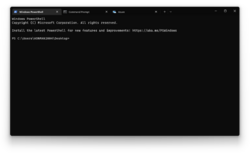Windows Terminal
 | |
| Type | Terminal emulator |
|---|---|
| Developer(s) | Microsoft |
| Operating system | Windows 10 Windows 11 |
| Supported platforms | x86, x64, ARM64 |
| Initial release version | 0.1.1002.0 |
| Initial release date | 2019-05-03 |
| Latest release version | 1.20.11781.0 |
| Latest release date | 2024-06-27 |
| Latest pre-release version | 1.21.1772.0 |
| Latest pre-release date | 2024-06-27 |
| License | MIT |
| Website | Official documentation GitHub |
Windows Terminal (codenamed Cascadia) is an open-source terminal emulator developed by Microsoft for Windows 10 and later. It was first announced at the Microsoft Build 2019 developer conference, aiming to be a modern replacement for the legacy Windows Console host, which is also built from the same source code repository and shares a number of components with it. Unlike the legacy host, it supports hardware accelerated rendering, includes better Unicode support and offers customization options comparable to other similar applications for different platforms. It can also run multiple console applications in tabs, each of which can be further divided to panes.
The Terminal bundles the purpose-built monospace Cascadia Code font, which includes support for programming ligatures as well as PowerLine glyphs. It has since been adopted as the default font for Visual Studio 2022.
History[edit | edit source]
Windows Terminal was announced at Microsoft's Build 2019 developer conference in May 2019 as a modern alternative for the Windows Console.[1] Windows Terminal's source code first appeared on GitHub on 3 May 2019.[2] The first preview release was version 0.2, which appeared on 10 July 2019.[3] The first stable version of the project (version 1.0) was released on 19 May 2020, at which point, Microsoft started releasing preview versions as the Windows Terminal Preview app, which could be installed side-by-side with the stable version.[4]
Starting with Windows 10 build 21337.1000, it comes pre-installed with Windows, with the first publicly released version to come with it being the original release of Windows 11. Starting with Windows 11 build 25188, Windows Terminal has been set as the default terminal application of the operating system, replacing the legacy Windows Console host.





















